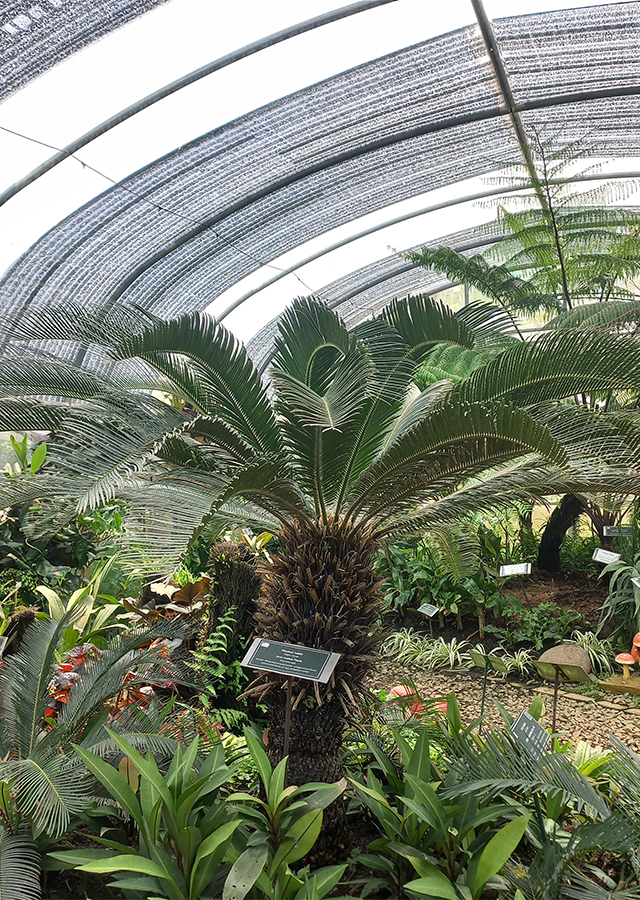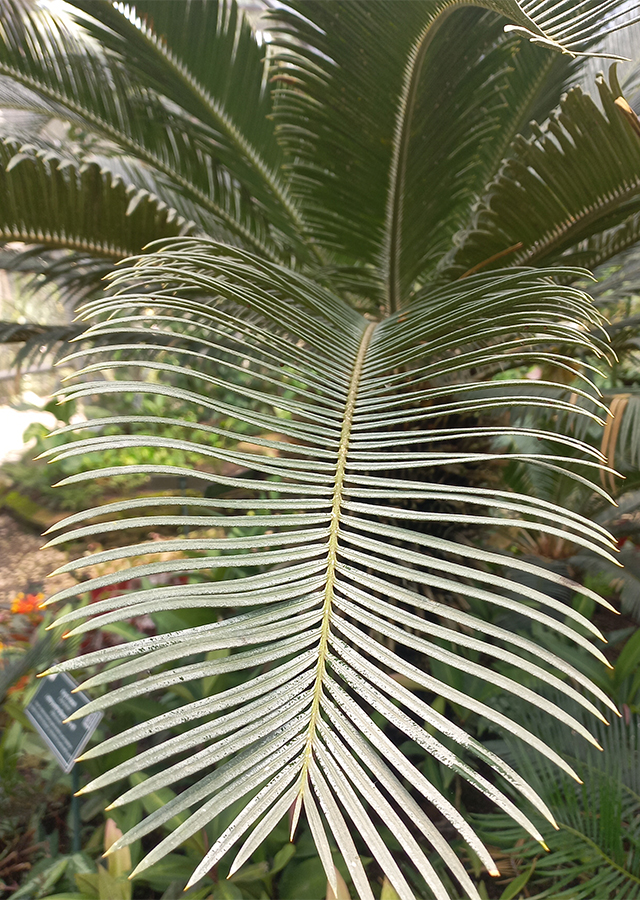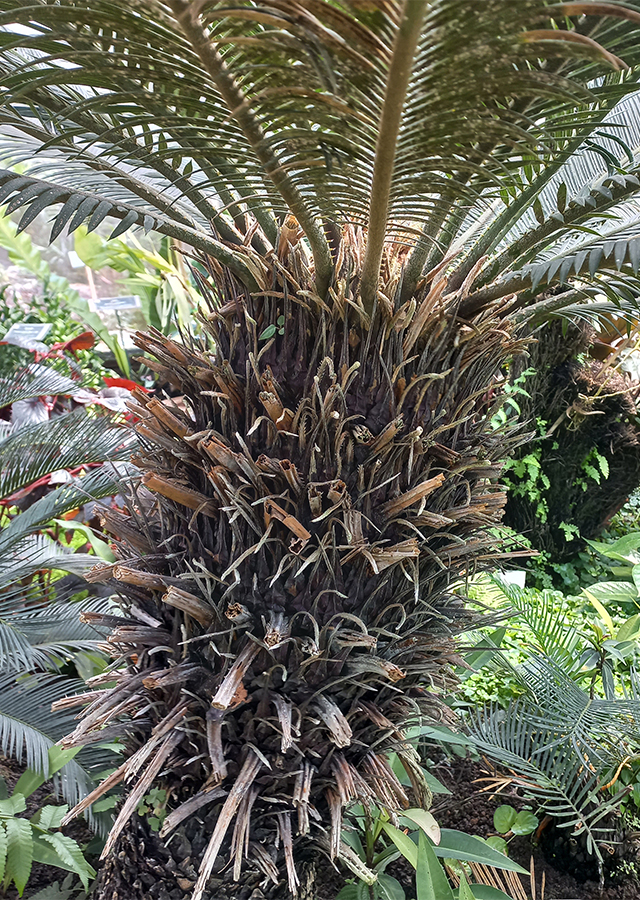Sago Cycas
Cycas revoluta Thunb.
Cycadaceae
Location in our garden
Palm



Synonym
Cycas inermis Oudem.
Cycas miquelii Warb.
Epicycas miquelii (Warb.) de Laub.
Habitus
Cycad. A slow-growing, evergreen palm-like plant with an erect main stem that is usually around 0.5 - 2 m tall
Part Used
Leaves
Seeds
Fruit
Latex
Growing Requirements
Full Sunshine
Need Shade
Habitat
Coastal
Rocky Areas
Shrublands
Overview
Cycas revoluta is native from E. Asia - southern China, southern Japan. The plant is harvested from the wild for local use as a food and medicine. It is sometimes cultivated as a food plant in Japan, Taiwan and India, and is also commonly grown as an ornamental in gardens and parks, and is a popular bonsai subject. The leaves are used as decorative material, and have been exported in quantity from Japan for this purpose. This plant is also used as a traditional medicine.
Vernacular Names
King sago palm (English), Bi huo jiao, Feng wei jiao, Feng wei song, Feng wei cao, Su tie, Tie shu (Chinese), Cykas japonsky (Czech), Sagopalme (Danish), Saagopalmu (Finnish), Cycas du Japon, Cycas sagoutier (Franch), Sagopalme (German), Palma a sagu (Italian), So-tetsu (Japanese), So ch'eol, (Korean), Sagovnik ponikaiushchii, Sagovnik ponikaiushchii drevovidnyi, Tsikas ponikaiushchii (Russian), Cicas revoluta, Palma sagú, Sagutero (Spanish).
Agroecology
Cycas revoluta is probably the hardiest cycad, able to tolerate light frosts, with reports of plants withstanding temperatures as low as -6 °C. It can be grown from the warm temperate zone through to the tropics. Requires a sunny position. Plants are sometimes found in dense shade in the wild. Requires a strong loam with sharp sand and good drainage. Succeeds in dry soils. Plants are tolerant of saline conditions.
Morphology
- Roots - are fibrous and black.
- Stems - strong/stocky and cylindrical stems are characterized by prominent scars, blackish brown leaf stalks. sometimes branch.
- Leaves - are many, lush, spreading, 0.5-1.5 meters long. The leaf blades are numerous, close together, and linear. Middle length 18 cm, width 4 to 6 mm, smooth top surface, hairy bottom.
- Flowers - vary in the form of bunches. Male flowers are short-stemmed, cone-shaped with a length of 10-20 cm and yellow. The female flowers are surrounded by brownish yellow male flowers.
- Fruits - an egg-shaped box with a diameter of 1 cm and is green.
- Seeds - on leaves that are loosely arranged around the stem. The seeds are large, like plums, and pale yellow to brown in color.
Cultivation
- Propagated by seeds, best sown as soon as they are ripe, though the seeds of many species will take a few months to finish maturing the embryo before they are ready to germinate. Sow the seeds in a tray in a freely-draining medium and place in moderate shade. Bottom heat at about 27 °C will hasten seed germination dramatically. Young roots are quite brittle and once germination takes place, the root grows rapidly. It is important to pot up the seedlings at this time in order to give them enough root-space. Grow on the plants in pots until large enough to plant out.
- Propagated by division of off-sets or suckers is best carried out just before the plant comes in to new growth at the start of the growing season.
Chemical Constituents
Leptin, B-N-methylamin-L-alanine (BMAA), cycasindene, 5 components of fatty acids (linolenic acid, oleic acid, linoleic acids, palmitic acid and octadecanoic acid), two new dihydroamentoflavone glucosides [(2S)-I-(2,3)-dihydro-I-7-O-β-d-glucopyranosylamentoflavone and (2S)-I-(2,3)-dihydro-I-7,II-7-di-O-β-d-glucopyranosylamentoflavone], prunin, vitexin-2″-rhamnoside, protocatechuic acid, cycasin and methylazoxymethan (neurotoxic and carcinogenic) methylamino-L-alanine (toxin).
Traditional Medicinal Uses
- The leaves are used in the treatment of cancer and hepatoma.
- The seed is emmenagogue, expectorant and tonic. It is used in the treatment of rheumatism. Substances extracted from the seeds are used to inhibit the growth of malignant tumours.
- A gum obtained from the plant has been used medicinally, particularly as an agent that is said to produce rapid suppuration when applied to malignant ulcers. The gum also has the repute of being a good antidote for snake and insect bites.
Part Used
Reference Sources
- Flora Fauna Web. 2019. Cycas revoluta. https://www.nparks.gov.sg/florafaunaweb/flora/5/1/5108. 22-11-2021.
- Useful Tropical Plants. 2021. Cycas revoluta. http://tropical.theferns.info/viewtropical.php?id=Cycas+revoluta. 22-11-2021.
- Stuartxchange. 2018. Philippine Medicinal Plants: Oliba. http://www.stuartxchange.org/Oliba. 22-11-2021.


